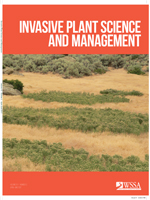Pale swallowwort and black swallowwort are European viny milkweeds that have become invasive in many habitats in the northeastern United States and southeastern Canada. A multiyear seedbank study was initiated in fall 2011 to assess annual emergence of seedlings and longevity of seeds of pale swallowwort and black swallowwort at four different burial depths (0, 1, 5, and 10 cm) over 4 yr. One hundred swallowwort seeds were sown in seed pans buried in individual pots, and emerged seedlings were counted and removed from May through September each year. A subset of seed pans was retrieved annually in October, and recovered seeds were counted and tested for viability. The majority of seedling emergence occurred during the first year (92% in 2012), and no new seedlings emerged in the third (2014) or fourth (2015) years. Pale swallowwort had relatively poor emergence at sowing depths of 0 cm (11%), 5 cm (6%), and 10 cm (0.05%—only one seedling), while 37% of pale swallowwort seeds emerged at 1 cm. The larger-seeded black swallowwort was more successful, with two-thirds of all sown seeds emerging at depths of 1 cm (71%) and 5 cm (66%), and 26% emerging at 10 cm. Only 16% of the surface-sown black swallowwort emerged. A large portion of the seeds that germinated at 10 cm, as well as at 5 cm for pale swallowwort, died before reaching the soil surface. Of filled seeds that were recovered in 2012 (black swallowwort at the 0-cm depth), 66% were viable. No viable seeds were recovered after the second growing season. Seeds recovered following the third year had become too deteriorated to accurately assess. Swallowwort seeds do not appear to survive more than 2 yr in the soil, at least in our experiment, suggesting that the elimination of seed production over 3 yr will exhaust the local seedbank. Seeds would need to be buried at least 10 cm for pale swallowwort but more than 10 cm for black swallowwort to prevent seedling emergence. Burial of swallowwort seeds as a management strategy may, however, only be practical in natural areas where high swallowwort densities occur.
Nomenclature: Black swallowwort, Vincetoxicum nigrum (L.) Moench [Cynanchum louiseae Kartesz & Gandhi]; pale (or European) swallowwort, V. rossicum (Kleopow) Barbar. [Cynanchum rossicum (Kleopow) Borhidi].






